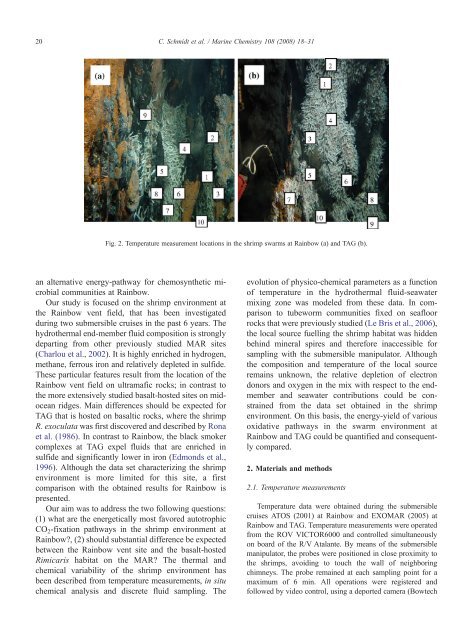Geochemical energy sources for microbial primary production in the ...
Geochemical energy sources for microbial primary production in the ...
Geochemical energy sources for microbial primary production in the ...
Create successful ePaper yourself
Turn your PDF publications into a flip-book with our unique Google optimized e-Paper software.
20 C. Schmidt et al. / Mar<strong>in</strong>e Chemistry 108 (2008) 18–31<br />
Fig. 2. Temperature measurement locations <strong>in</strong> <strong>the</strong> shrimp swarms at Ra<strong>in</strong>bow (a) and TAG (b).<br />
an alternative <strong>energy</strong>-pathway <strong>for</strong> chemosyn<strong>the</strong>tic <strong>microbial</strong><br />
communities at Ra<strong>in</strong>bow.<br />
Our study is focused on <strong>the</strong> shrimp environment at<br />
<strong>the</strong> Ra<strong>in</strong>bow vent field, that has been <strong>in</strong>vestigated<br />
dur<strong>in</strong>g two submersible cruises <strong>in</strong> <strong>the</strong> past 6 years. The<br />
hydro<strong>the</strong>rmal end-member fluid composition is strongly<br />
depart<strong>in</strong>g from o<strong>the</strong>r previously studied MAR sites<br />
(Charlou et al., 2002). It is highly enriched <strong>in</strong> hydrogen,<br />
methane, ferrous iron and relatively depleted <strong>in</strong> sulfide.<br />
These particular features result from <strong>the</strong> location of <strong>the</strong><br />
Ra<strong>in</strong>bow vent field on ultramafic rocks; <strong>in</strong> contrast to<br />
<strong>the</strong> more extensively studied basalt-hosted sites on midocean<br />
ridges. Ma<strong>in</strong> differences should be expected <strong>for</strong><br />
TAG that is hosted on basaltic rocks, where <strong>the</strong> shrimp<br />
R. exoculata was first discovered and described by Rona<br />
et al. (1986). In contrast to Ra<strong>in</strong>bow, <strong>the</strong> black smoker<br />
complexes at TAG expel fluids that are enriched <strong>in</strong><br />
sulfide and significantly lower <strong>in</strong> iron (Edmonds et al.,<br />
1996). Although <strong>the</strong> data set characteriz<strong>in</strong>g <strong>the</strong> shrimp<br />
environment is more limited <strong>for</strong> this site, a first<br />
comparison with <strong>the</strong> obta<strong>in</strong>ed results <strong>for</strong> Ra<strong>in</strong>bow is<br />
presented.<br />
Our aim was to address <strong>the</strong> two follow<strong>in</strong>g questions:<br />
(1) what are <strong>the</strong> energetically most favored autotrophic<br />
CO 2 -fixation pathways <strong>in</strong> <strong>the</strong> shrimp environment at<br />
Ra<strong>in</strong>bow?, (2) should substantial difference be expected<br />
between <strong>the</strong> Ra<strong>in</strong>bow vent site and <strong>the</strong> basalt-hosted<br />
Rimicaris habitat on <strong>the</strong> MAR? The <strong>the</strong>rmal and<br />
chemical variability of <strong>the</strong> shrimp environment has<br />
been described from temperature measurements, <strong>in</strong> situ<br />
chemical analysis and discrete fluid sampl<strong>in</strong>g. The<br />
evolution of physico-chemical parameters as a function<br />
of temperature <strong>in</strong> <strong>the</strong> hydro<strong>the</strong>rmal fluid-seawater<br />
mix<strong>in</strong>g zone was modeled from <strong>the</strong>se data. In comparison<br />
to tubeworm communities fixed on seafloor<br />
rocks that were previously studied (Le Bris et al., 2006),<br />
<strong>the</strong> local source fuell<strong>in</strong>g <strong>the</strong> shrimp habitat was hidden<br />
beh<strong>in</strong>d m<strong>in</strong>eral spires and <strong>the</strong>re<strong>for</strong>e <strong>in</strong>accessible <strong>for</strong><br />
sampl<strong>in</strong>g with <strong>the</strong> submersible manipulator. Although<br />
<strong>the</strong> composition and temperature of <strong>the</strong> local source<br />
rema<strong>in</strong>s unknown, <strong>the</strong> relative depletion of electron<br />
donors and oxygen <strong>in</strong> <strong>the</strong> mix with respect to <strong>the</strong> endmember<br />
and seawater contributions could be constra<strong>in</strong>ed<br />
from <strong>the</strong> data set obta<strong>in</strong>ed <strong>in</strong> <strong>the</strong> shrimp<br />
environment. On this basis, <strong>the</strong> <strong>energy</strong>-yield of various<br />
oxidative pathways <strong>in</strong> <strong>the</strong> swarm environment at<br />
Ra<strong>in</strong>bow and TAG could be quantified and consequently<br />
compared.<br />
2. Materials and methods<br />
2.1. Temperature measurements<br />
Temperature data were obta<strong>in</strong>ed dur<strong>in</strong>g <strong>the</strong> submersible<br />
cruises ATOS (2001) at Ra<strong>in</strong>bow and EXOMAR (2005) at<br />
Ra<strong>in</strong>bow and TAG. Temperature measurements were operated<br />
from <strong>the</strong> ROV VICTOR6000 and controlled simultaneously<br />
on board of <strong>the</strong> R/V Atalante. By means of <strong>the</strong> submersible<br />
manipulator, <strong>the</strong> probes were positioned <strong>in</strong> close proximity to<br />
<strong>the</strong> shrimps, avoid<strong>in</strong>g to touch <strong>the</strong> wall of neighbor<strong>in</strong>g<br />
chimneys. The probe rema<strong>in</strong>ed at each sampl<strong>in</strong>g po<strong>in</strong>t <strong>for</strong> a<br />
maximum of 6 m<strong>in</strong>. All operations were registered and<br />
followed by video control, us<strong>in</strong>g a deported camera (Bowtech
















